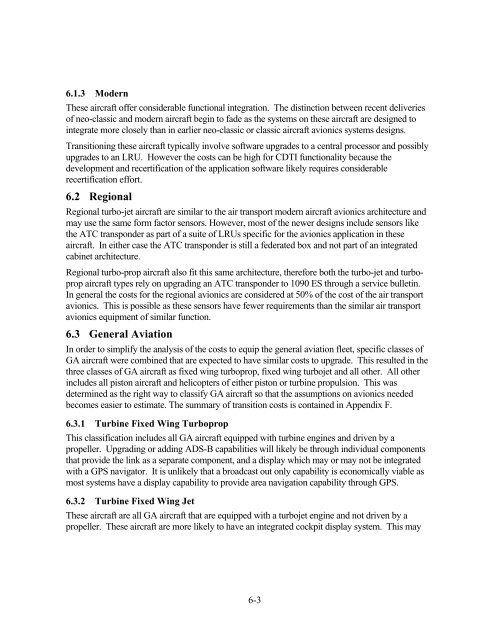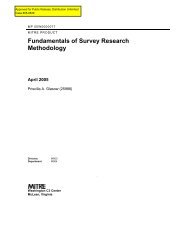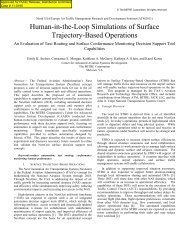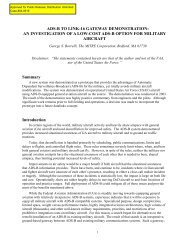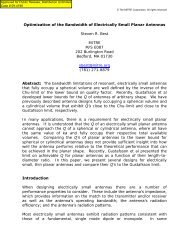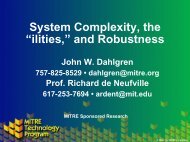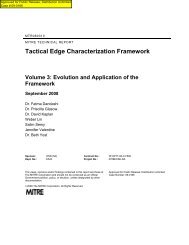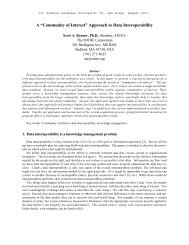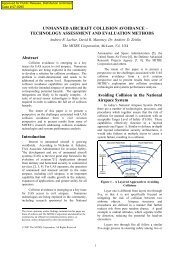A Predictive Model of User Equipage Costs for Future Air ... - Mitre
A Predictive Model of User Equipage Costs for Future Air ... - Mitre
A Predictive Model of User Equipage Costs for Future Air ... - Mitre
Create successful ePaper yourself
Turn your PDF publications into a flip-book with our unique Google optimized e-Paper software.
6.1.3 Modern<br />
These aircraft <strong>of</strong>fer considerable functional integration. The distinction between recent deliveries<br />
<strong>of</strong> neo-classic and modern aircraft begin to fade as the systems on these aircraft are designed to<br />
integrate more closely than in earlier neo-classic or classic aircraft avionics systems designs.<br />
Transitioning these aircraft typically involve s<strong>of</strong>tware upgrades to a central processor and possibly<br />
upgrades to an LRU. However the costs can be high <strong>for</strong> CDTI functionality because the<br />
development and recertification <strong>of</strong> the application s<strong>of</strong>tware likely requires considerable<br />
recertification ef<strong>for</strong>t.<br />
6.2 Regional<br />
Regional turbo-jet aircraft are similar to the air transport modern aircraft avionics architecture and<br />
may use the same <strong>for</strong>m factor sensors. However, most <strong>of</strong> the newer designs include sensors like<br />
the ATC transponder as part <strong>of</strong> a suite <strong>of</strong> LRUs specific <strong>for</strong> the avionics application in these<br />
aircraft. In either case the ATC transponder is still a federated box and not part <strong>of</strong> an integrated<br />
cabinet architecture.<br />
Regional turbo-prop aircraft also fit this same architecture, there<strong>for</strong>e both the turbo-jet and turboprop<br />
aircraft types rely on upgrading an ATC transponder to 1090 ES through a service bulletin.<br />
In general the costs <strong>for</strong> the regional avionics are considered at 50% <strong>of</strong> the cost <strong>of</strong> the air transport<br />
avionics. This is possible as these sensors have fewer requirements than the similar air transport<br />
avionics equipment <strong>of</strong> similar function.<br />
6.3 General Aviation<br />
In order to simplify the analysis <strong>of</strong> the costs to equip the general aviation fleet, specific classes <strong>of</strong><br />
GA aircraft were combined that are expected to have similar costs to upgrade. This resulted in the<br />
three classes <strong>of</strong> GA aircraft as fixed wing turboprop, fixed wing turbojet and all other. All other<br />
includes all piston aircraft and helicopters <strong>of</strong> either piston or turbine propulsion. This was<br />
determined as the right way to classify GA aircraft so that the assumptions on avionics needed<br />
becomes easier to estimate. The summary <strong>of</strong> transition costs is contained in Appendix F.<br />
6.3.1 Turbine Fixed Wing Turboprop<br />
This classification includes all GA aircraft equipped with turbine engines and driven by a<br />
propeller. Upgrading or adding ADS-B capabilities will likely be through individual components<br />
that provide the link as a separate component, and a display which may or may not be integrated<br />
with a GPS navigator. It is unlikely that a broadcast out only capability is economically viable as<br />
most systems have a display capability to provide area navigation capability through GPS.<br />
6.3.2 Turbine Fixed Wing Jet<br />
These aircraft are all GA aircraft that are equipped with a turbojet engine and not driven by a<br />
propeller. These aircraft are more likely to have an integrated cockpit display system. This may<br />
6-3


